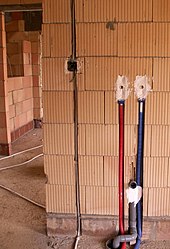Plumbing

Plumbing(which comes from theLatinwordplumbum,which meanslead,as pipes were once made from lead) is the job of working withpipes,tubing and plumbing fixtures fordrinking watersystems and getting rid of waste. Aplumberis someone who fixes or puts in piping systems, plumbing fixtures and equipment such as water heaters. Many plumbers areconstruction workers.The plumbing industry is an important part of every developedeconomybecause people need clean water and safe ways to move and store waste.[1]
Plumbing also refers to a system of pipes and fixtures put in a building to move water and the get rid of waste that is in water. Plumbing is different from water andsewage systemsbecause plumbing system serves one building, while water and sewage systems serve a group of buildings or a city.
History
[change|change source]
Plumbing was very rare until modern cities grew in the 19th century. At about the same time,public healthleaders began wanting better systems to get rid of waste. Before this, people got rid of waste by collecting it and dumping it onto the ground or intorivers.However, there were some plumbing pipes in the city settlements of theIndus Valley Civilizationby 2700 B.C.[2]Plumbing was also used during the ancient civilizations such as the Greek, Roman, Persian, Indian, andChinesecivilizations as they built public baths and needed drinking water, and somewhere to drain waste. The Romans used pipe inscriptions to stop people from stealing water.
These systems did not improve much over the years. There were almost no improvements from the time of the Romanaqueductsandsewers until the 19th century. Eventually the development of separate, underground water and sewage systems got rid of open sewage ditches andcesspools.Most large cities today send solid wastes through pipes tosewage treatmentplants. Treatment separates water from waste and makes the water morepurebefore it goes into streams or other bodies of water. Most places stopped usingleadfor drinking water afterWorld War IIbecause of the dangers oflead poisoning.At this time,copperpiping was started because it was safer than using lead pipes.[3]
Materials
[change|change source]Water systems in ancient times usedgravityto move water. They used pipes or channels usually made ofclay,lead,bambooor stone. Today, water-supply systems use a network of high-pressure pumps, and pipes are now made of copper,[4]brass, plastic, or other nontoxic material. Drain and vent lines are made of plastic, steel, cast-iron, and lead. Lead is not used in pipes today because it can be poisonous.[5][6][7]


The 'straight' sections of plumbing systems are ofpipeortube.A pipe is usually made by casting orwelding,where a tube is made through extrusion. Pipe usually has thicker walls and may be threaded or welded, where tubes have thinner walls, and needs special joining techniques such as 'brazing', 'compression fitting', 'crimping', or for plastics, 'solvent welding'.
As well as the straight pipe or tubing, many fittings are required in plumbing systems, such as valves, elbows, tees, and unions.
Plumbing fixtures are designed for the people who use the water. Some examples of fixtures include water closets (also known astoilets),urinals,bidets,showers,bathtubs,utility and kitchensinks,drinking fountains,ice makers,humidifiers, air washers,fountains,and eye wash stations.[8]
Regulation
[change|change source]Much of the plumbing work in places where many people live is done undergovernmentrules. Putting in plumbing and fi xing plumbing generally must be done according to plumbing andbuilding codesto protect the people who live or work in the buildings.[9]
References
[change|change source]- ↑Plumbing: the Arteries of Civilization,Modern Marvels video series, The History Channel, AAE-42223, A&E Television, 1996
- ↑Teresi et al. 2002
- ↑ Kavanaugh, Sean."History of Plumbing Pipe and Plumbing Material".
- ↑Copper Tube Handbook,the Copper Development Association, New York, USA, 2006
- ↑Uniform Plumbing Code,IAPMO
- ↑International Plumbing Code,ICC
- ↑"Lead Pipe History".Archived fromthe originalon 2014-02-26.Retrieved2010-01-12.
- ↑Carl, Jacy."Bathroom Installation".Archived fromthe originalon 2020-11-30.Retrieved2020-11-23.
- ↑"AnytimePlumbing".
